Статьи журнала - International Journal of Intelligent Systems and Applications
Все статьи: 1126
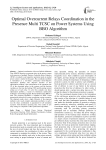
Статья научная
Optimal coordination of Inverse Definite Minimum Time (IDMT) direction overcurrent relays in the power systems in the presence of multiple Thyristor Controller Series Capacitor (TCSC) on inductive and capacitive operation mode on meshed power system is studied in this paper. The coordination problem is formulated as a non-linear constrained mono-objective optimization problem. The objective function of this optimization problem is the minimization of the operation time (T) of the associated relays in the systems, and the decision variables are: the time dial setting (TDS) and the pickup current setting (IP) of each relay. To solve this complex non linear optimization problem, a variant of evolutionary optimization techniques named Biogeography Based Optimization (BBO) is used. The proposed algorithm is validated on IEEE 14-bus transmission network test system considering various scenarios. The obtained results show a high efficiency of the proposed method to solve such complex optimization problem, in such a way the relays coordination is guaranteed for all simulation scenarios with minimum operating time. The results of new relay setting are compared to other optimization algorithms.
Бесплатно
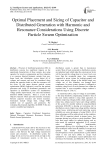
Статья научная
Presence of distributed generation (DG) in distribution systems has significant impacts on the operational characteristics of these systems, also using capacitor for reactive compensation and loss reduction is so common. Injected harmonic currents from non-linear loads into distribution system distort all of voltages and currents and must be considered when placing the capacitor banks so that the resonance will not occur. In this paper discrete particle swarm optimization (DPSO) approach is used for the optimal placement and sizing of distributed generations and capacitors in distribution systems for simultaneous voltage profile improvement, loss and total harmonic distortion (THD) reduction. There is a term in the objective function which prevents harmonic resonance between capacitor reactance and system reactance. Constraints include voltage limit, voltage THD, number/ size of capacitors and generators. For evaluating the proposed algorithm, the IEEE 33-bus test system is modified and employed.
Бесплатно
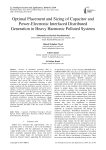
Статья научная
Presence of distributed generation (DG) in distribution systems has significant impacts on the operational characteristics of these systems, also using capacitor for reactive compensation and loss reduction is so common. Injected harmonic currents from non-linear loads into distribution system distort all of voltages and currents and must be considered when placing the capacitor banks so that the resonance will not occur. Distributed Generation is often connected to the network via power-electronic interfaces for a proper coupling with the distribution networks. Inverters are capable of producing harmonic components and can be used as ancillary services for reducing harmonics by designing of a proper controlling system. In this paper discrete particle swarm optimization (DPSO) approach is used for the optimal placement and sizing of distributed generations and capacitors in distorted distribution systems for simultaneous voltage profile improvement, loss and total harmonic distortion (THD) reduction. Constraints include voltage limit, voltage THD, number/ size of capacitors and generators. For evaluating the proposed algorithm, the IEEE 33-bus test system is modified and employed.
Бесплатно
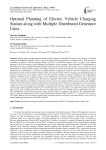
Статья научная
Saving energy through the minimization of power losses in a distribution system is a key activity for efficient operation. Distributed Generation (DG) is one of the most efficient approaches to minimize losses. With increase in installation of Electric Vehicle Charging Stations (EVCSs) for Electrical Vehicles (EVs) in larger scale, optimal planning of EVCSs becomes a major challenge for distribution system operator. With increased EV load penetration in the electricity system, generation-demand mismatch and power losses increases. This results in poor voltage level, and deterioration in voltage stability margin. To mitigate the adverse impacts of increasing EV load penetration on Radial Distribution Systems (RDS), it is essential to integrate EVCSs at appropriate locations. The EVs integration into smart distribution systems involves Grid-to-Vehicle (G2V) and Vehicle-to-Grid (V2G) in charging and discharging modes of operation respectively for exchange of power with the grid thus resulting in energy management. The inappropriate planning of EVCSs causes a negative impact on the distribution system such as voltage deviation and an increase in power losses. In order to minimize this, DG units are integrated with EVCSs. The DGs assist in keeping the voltage profile within limitations, resulting in reduced power flows and losses, thereby enhancing power quality and reliability. Therefore, the DGs should be optimally allocated and sized along with the EVCS to avoid problems such as protection, voltage rise, and reverse power flow problems. This paper showcases a method to minimize losses using optimal location and sizing of multiple DGs and EVCS operating in G2V and V2G modes. The sizing and location of different types of DG units including renewables and non-renewables along with EV charging station is proposed in this study. This methodology overall reduces the power losses and also improves voltages of the network. The implementation is done by using the Simultaneous Particle Swarm Optimization technique (PSO) for IEEE 15, 33, 69 and 85 bus systems. The results indicate that the proposed optimization technique improves efficiency and performance of the system by optimal planning and operation of both DGs and EVs.
Бесплатно
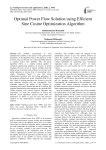
Optimal Power Flow Solution using Efficient Sine Cosine Optimization Algorithm
Статья научная
The problem encountered in most metaheuristic methods is the choice of the good control parameters of the algorithm. That is the objective of this work by using an efficient sine cosine algorithm (ESCA) in optimal power flow problem. The sine-cosine algorithm (SCA) is a modern method applied in numerical optimization problems. It consists of search randomly the best vector of control variables from the initial group of elements and oscillates to converge to the global optimum or diverge from it, functioning with a simple formulation based on sine and cosine mathematical functions with few setting parameters. In the proposed efficient sine cosine Algorithm (ESCA) the best values of setting parameters are chosen to give the best optimum solution with fast convergence. This technique improves the quality of the solution by exploring more search domain than the SCA method. The modified algorithm has been applied to the classical IEEE 30-Bus network with various objective functions and constraints. To make the comparison of ESCA and different recent algorithms, present results show the importance of ESCA to give the best and effective solution to the multi-objective optimal power flow problem.
Бесплатно
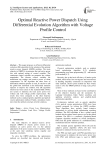
Optimal Reactive Power Dispatch Using Differential Evolution Algorithm with Voltage Profile Control
Статья научная
This paper proposes an efficient differential evolution (DE) algorithm for the solution of the optimal reactive power dispatch (ORPD) problem. The main objective of ORPD is to minimize the total active power loss with optimal setting of control variables. The continuous control variables are generator bus voltage magnitudes. The discrete control variables are transformer tap settings and reactive power of shunt compensators. In DE algorithm the other form of differential mutation operator is used. It consists to add the global best individual in the differential mutation operator to improve the solution. The DE algorithm solution has been tested on the standard IEEE 30-Bus test system to minimize the total active power loss without and with voltage profile improvement. The results have been compared to the other heuristic methods such as standard genetic algorithm and particle swarm optimization method. Finally, simulation results show that this method converges to better solutions.
Бесплатно
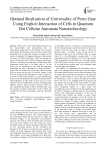
Статья научная
The essence of the technology business lies in the improvements and advancements that are continuously taking place in the industry. From vacuum tubes, diodes and transistors to the concepts of nano level designing have by and large created a revolution in the history of mankind. The biggest milestone in this journey has been the CMOS technology which has managed to survive for decades and is still an ongoing research area. However, advancing the technology includes many other dimensions which need to be taken care of. As the devices go on decreasing in size with the improving technology the power dissipation in them becomes a major issue. To counter this, a new logic called reversible logic has come into the pool of research. Further a shift from the transistor based paradigm is being explored to go down to ultra-small structures. A major breakthrough in this can be the Quantum Dot Cellular Automata (QCA) Nanotechnology. In this paper we have given a review about how the reversible logic and QCA nanotechnology together result in ultra-low power designs. Further we have optimized the design of Peres reversible gate using the concepts of explicit interaction of cells in QCA and verified the universal functionality using the optimized designs.
Бесплатно
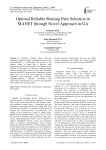
Optimal Reliable Routing Path Selection in MANET through Novel Approach in GA
Статья научная
In MANETs (Mobile Adhoc Network) judgment in optimal reliable routing path between source and destination is a challenging task because of the mobility nature of nodes and is deficient in the infrastructure of the network which is so dynamic. So the objective of this paper is to identify an optimal reliable ordered routing paths between source and destination nodes in MANET.To meet the above challenging task the paper focus on an new novel approach in Genetic Algorithm called Parametric fitness based Genetic Algorithm.Proposed algorithm hybridized with classification model rough sets as one key sub component which offers better accuracy results.
Бесплатно
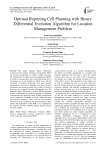
Статья научная
This paper presents binary differential evolution based optimal reporting cell planning (RCP) for location management in wireless cellular networks. The significance of mobile location management (MLM) in wireless communication has evolved drastically due to tremendous rise in the number of mobile users with the constraint of limited bandwidth. The total location management cost involves signaling cost due to location registration and location search and a trade-off between these two gives optimal location management cost. The proposed binary differential evolution (BDE) algorithm is used to determine the optimal reporting cell planning configuration such that the overall mobility management cost is minimized. Evidently, from the simulation result the proposed technique works well for the reference networks in terms of optimal cost and convergence speed. Further the applicability of the BDE is also validated for the realistic network of BSNL (Bharat Sanchar Nigam Limited), Odisha.
Бесплатно
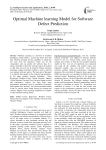
Optimal machine learning model for software defect prediction
Статья научная
Machine Learning is a division of Artificial Intelligence which builds a system that learns from the data. Machine learning has the capability of taking the raw data from the repository which can do the computation and can predict the software bug. It is always desirable to detect the software bug at the earliest so that time and cost can be reduced. Feature selection technique wrapper and filter method is used to find the most optimal software metrics. The main aim of the paper is to find the best model for the software bug prediction. In this paper machine learning techniques linear Regression, Random Forest, Neural Network, Support Vector Machine, Decision Tree, Decision Stump are used and comparative analysis has been done using performance parameters such as correlation, R-squared, mean square error, accuracy for software modules named as ant, ivy, tomcat, berek, camel, lucene, poi, synapse and velocity. Support vector machine outperform as compare to other machine learning model.
Бесплатно
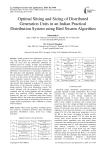
Статья научная
Indian practical rural distribution systems are very long and spread over a wide range of area. The nodes far away from the distribution substation are suffering from low voltage. In India, total distribution system losses are around 20% to 25%. From the past few years, penetration of distributed generation (DG) in to the distribution network/system is increasing expeditiously. DG allocation with appropriate location and size can provide numerous benefits to the distribution companies as well as to the society. In this regard, a new technique called combined sensitivity index (CSI), to find the optimal DG unit location, based on voltage sensitivity and network load magnitude is proposed. To assess the effectiveness of the proposed technique, it is tested on Indian practical 52-bus rural distribution system. The results obtained with the proposed CSI technique is compared with the results obtained with the combined power loss sensitivity (CPLS) technique. Here, the optimal DG unit size is calculated using Bird Swarm Algorithm (BSA). The results show that the proposed CSI technique performs better in minimizing power losses and voltage profile augmentation when compared to existing CPLS technique.
Бесплатно
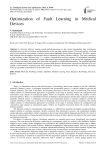
Optimization of Fault Learning in Medical Devices
Статья научная
A relatively effective training system and advancements in data science demonstrate their evolutionary algorithm power to discover defects and abnormalities in the specified learning process. This work employs a fast and precise fault modelling environment to enhance genetic input implantable devices defect diagnostics. We offer a genetic data technique that incorporates phylogenetic analysis operations and faulty efficiency analysis. This study contributes to fault training in three different ways: 1) it exposes communicative training categories of information formulating adhesion, 2) it introduces a hierarchical system dissemination processing principles to design the fault aggregative, and 3) it indicates forecasting the genetic data sector that corresponds to complicated fault training. The proposed algorithm analyses methods that combine automatically generated fault detection development with massive data testing by non-repetitive fault instances. Analyzing data from validation challenges, infrastructure blowouts, and failure uncertainty make our algorithm more productive in the health sector.
Бесплатно
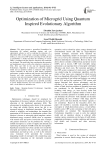
Optimization of Microgrid Using Quantum Inspired Evolutionary Algorithm
Статья научная
This paper presents a generalized formulation for determining the optimal operating strategy and cost optimization scheme as well as reducing the emissions of a MicroGrid (MG). In this article a microgrid including a wind turbine, pv array and a CHP system consisting of fuel cells and a microturbine is studied and then the modeling of various DERs is conducted and the objective functions and constraints are developed. The model takes into consideration the operation and maintenance costs as well as the reduction in emissions of NOx, SO2, and CO2 In the end the Quantum-Inspired Evolutionary Algorithm is employed to solved the optimal model and an operation scheme is achieved while meeting various constraints on the basis of tariff details, equipment performance, weather conditions and forecasts, load details and forecasts and other necessary information and then the economic costs and environmental impacts are analyzed and a conclusion that the QEA can achieve high environmental benefits and spend as low operation cost as possible. according to power Output functions and cost function of the various units , can be achieve to minimize cost.
Бесплатно
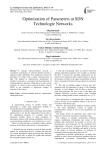
Optimization of Parameters at SDN Technologie Networks
Статья научная
A concept software-defined network is considered. Architecture of software-defined network is analyzed which, differently from traditional, foresee the separation of C-plane from a plane communication of data. The method of multicriterion optimization of multilevel networks is examined with determination of resulting objective function, which allows to carry out the synthesis of control system software-defined network (SDN) in the conditions of unforeseen changes of structure of the system.
Бесплатно
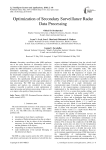
Optimization of secondary surveillance radar data processing
Статья научная
Secondary surveillance radar (SSR) performs one of the main functions of information service for consumers of the airspace control system. To improve the quality the SSR information is processed using modern information technology. The use of a consistent procedure for processing surveillance system data, due to the functionally completed stages of processing, made it possible to formalize the data processing procedure. However, this significantly limited, and in some cases excluded, the opportunities for inter-stage optimization of data processing. The SSR data processing structure synthesis and analysis are considered in this paper making it possible to perform a joint optimization of signal processing and primary processing of data, as well as to improve the quality of data processing.
Бесплатно

Optimized Angular a Star Algorithm for Global Path Search Based on Neighbor Node Evaluation
Статья научная
Any electromechanical device can be termed as Robot, which imitates human actions and in some of the situation can be used as a replacement for human. These days Robots are the integral part of our life and can be applied in several applications and tasks by giving respective commands. The research in robotics domain is to make it as autonomous and as much independent as it can be. The problem that arises is of controlling a mobile robot with the energy constraint. A lot of energy is wasted, if it takes wrong trajectory motion, this motion depends upon the robot knowledge which indeed in not constant. The variation in the environment results in making difficult for the robot to take precise and accurate measurements to reach the destination without much of the energy loss. An autonomous robot is expected to take decision according to the situation. For this precise decisions of robot path planning there are algorithms like A*, Dijkstra, D* etc. In this paper we have done analysis on partially known environment situation. Optimal path is planned by new heuristic approach over the A star algorithm, robot moving at an appropriate angle cuts down the unnecessary cost of path planning. Experimental results show that the proposed algorithm is much effective for more than 8% than the conventional A* algorithm in the same map environment.
Бесплатно
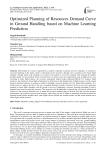
Optimized Planning of Resources Demand Curve in Ground Handling based on Machine Learning Prediction
Статья научная
Determining the resource requirements at airports especially in-ground services companies is essential to successful planning in the future, which is represented in the resources demand curve according to the future flight schedule, through which staff schedules are created at the airport to cover the workload with ensuring the highest possible quality service provided. Given in the presence of variety service level agreements used on flight service vary according to many flight features, the resources assumption method makes planning difficult. For instance, flight position is not included in future flight schedule but it's efficacious in the identification of flight resources. In this regard, based on machine learning, we propose a model for building a resource demand curve for future flight schedules. It is divided into two phases, the first is the use of machine learning to predict resources of the service level agreement required on future flight schedules, and the second is the use of implement a resource allocation algorithm to build a demand curve based on predicted resources. This proposal could be applicable to airports that will provide efficient and realistic for the resources demand curve to ensure the resource planning does not deviate from the real-time resource requirements. the model has proven good accuracy when using one day of flights to measuring deviation between the proposed model predict demand curve when flights did not include the location feature and the actual demand curve when flights include location.
Бесплатно
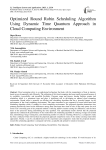
Статья научная
Cloud computing refers to a sophisticated technology that deals with the manipulation of data in internet-based servers dynamically and efficiently. The utilization of the cloud computing has been rapidly increased because of its scalability, accessibility, and incredible flexibility. Dynamic usage and process sharing facilities require task scheduling which is a prominent issue and plays a significant role in developing an optimal cloud computing environment. Round robin is generally an efficient task scheduling algorithm that has a powerful impact on the performance of the cloud computing environment. This paper introduces a new approach for round robin based task scheduling algorithm which is suitable for cloud computing environment. The proposed algorithm determines time quantum dynamically based on the differences among three maximum burst time of tasks in the ready queue for each round. The concerning part of the proposed method is utilizing additive manner among the differences, and the burst times of the processes during determining the time quantum. The experimental results showed that the proposed approach has enhanced the performance of the round robin task scheduling algorithm in reducing average turn-around time, diminishing average waiting time, and minimizing number of contexts switching. Moreover, a comparative study has been conducted which showed that the proposed approach outperforms some of the similar existing round robin approaches. Finally, it can be concluded based on the experiment and comparative study that the proposed dynamic round robin scheduling algorithm is comparatively better, acceptable and optimal for cloud environment.
Бесплатно
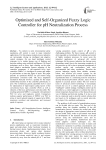
Optimized and Self-Organized Fuzzy Logic Controller for pH Neutralization Process
Статья научная
To conform to strict environmental safety regulations, pH control is used in many industrial applications. For this purpose modern process industries are increasingly relying on intelligent and adaptive control strategies. On one hand intelligent control strategies try to imitate human way of thinking and decision making using artificial intelligence (AI) based techniques such as fuzzy logic whereas on the other hand adaptive mechanism ensures adjusting of the controller parameters. A self-organized fuzzy logic controller (SOFLC) is intelligent in nature and adapts its performance to meet the figure of merit. This paper presents an optimized SOFLC for pH control using performance correction table. The fuzzy adaptation mechanism basically involves a penalty for the output membership functions if the controller performance is poor. The evolutionary genetic algorithm (GA) is used for optimization of input-output scaling factors of the conventional fuzzy logic controller (FLC) as well as elements of the fuzzy performance correction table. The resulting optimized SOFLC is compared with optimized FLC for servo and regulatory control. Comparison indicate superior performance of SOFLC over FLC in terms of much reduced integral of squared error (ISE), maximum overshoot and undershoot, and increased speed of response.
Бесплатно
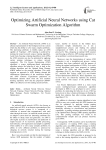
Optimizing Artificial Neural Networks using Cat Swarm Optimization Algorithm
Статья научная
An Artificial Neural Network (ANN) is an abstract representation of the biological nervous system which has the ability to solve many complex problems. The interesting attributes it exhibits makes an ANN capable of “learning”. ANN learning is achieved by training the neural network using a training algorithm. Aside from choosing a training algorithm to train ANNs, the ANN structure can also be optimized by applying certain pruning techniques to reduce network complexity. The Cat Swarm Optimization (CSO) algorithm, a swarm intelligence-based optimization algorithm mimics the behavior of cats, is used as the training algorithm and the Optimal Brain Damage (OBD) method as the pruning algorithm. This study suggests an approach to ANN training through the simultaneous optimization of the connection weights and ANN structure. Experiments performed on benchmark datasets taken from the UCI machine learning repository show that the proposed CSONN-OBD is an effective tool for training neural networks.
Бесплатно

